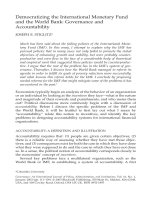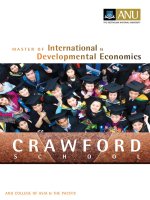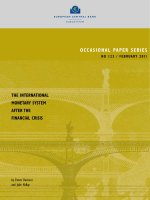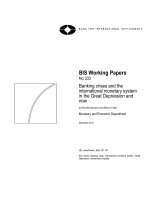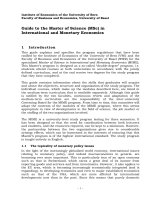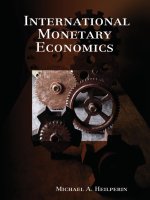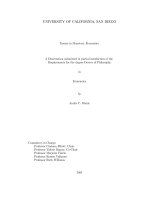International monetary economics
Bạn đang xem bản rút gọn của tài liệu. Xem và tải ngay bản đầy đủ của tài liệu tại đây (13.56 MB, 293 trang )
INTERNATIONAL
MONETARY ECONOMICS
INTERNATIONAL
MONETARY ECONOMICS
By
MICHAEL
A.
HEILPERIN, D.Sc. (Econ.)
Assistant Professor
at the
Graduate Institute
of International Studies, Geneva
LONGMANS, GREEN AND CO.
LONDON
<- NEW
YORK
o
TORONTO
LONGMANS,
GREEN
AND
CO.
LTD.
39 PATERNOSTER ROW, LONDON, E.C.4
I 7
CHITTARANJAN
AVENUE,
CALCUTTA
NICOL ROAD, BOMBAY
36A MOUNT ROAD, MADRAS
LONGMANS, GREEN AND
CO.
114 FIFTH AVENUE, NEW YORK
221 EAST 2OTH STREET, CHICAGO
88 TREMONT STREET, BOSTON
LONGMANS, GREEN AND
CO.
215 VICTORIA STREET, TORONTO
First
published
ig3g
PRINTED
IN
GREAT BRITAIN BY WESTERN PRINTING SERVICES LTD., BRISTOL
To
MY COLLEAGUES AND FRIENDS
OF
THE GRADUATE INSTITUTE
OF
INTERNATIONAL STUDIES
PREFACE
T
HE scope of this book covers an investigation of the
structure of international monetary
relations,
an inquiry
into the nature of monetary internationalism and into
the conditions which make its continued existence possible,
and an investigation of the consequences of its destruction
and replacement by nationalistic monetary policies.
While the only successful experience of monetary inter-
nationalism (apart from monetary unions) has been under
the gold standard, the present study is not primarily con-
cerned with that system, even though much of the following
discussion will throw light upon its functioning. After defin-
ing the nature of monetary internationalism and of its oppo-
site,
the present inquiry proceeds to discuss what might be
called the monetary economics of gold. It is important to
determine the action of gold on prices and the part played
by gold in the functioning of a monetary system in order to
define, later on, its importance for monetary internationalism.
There follows a detailed analysis of various problems relating
to international payments and their balance, to exchange
rates and parities, and to the conditions of monetary stability,
which are considered on a fairly broad basis including both
national economic policies and international political rela-
tions.
The experience of the reconstruction of monetary
internationalism which was carried out in the middle 'twenties
and which collapsed so soon remains a proof of what may
happen if in considering monetary matters one confines one-
self to the field of purely technical monetary considerations.
All economic relations have a monetary aspect; but, recipro-
vii
PREFACE
cally, monetary relations exist only within the framework of
an economic "system", and cannot be treated, least of all in
practice, apart from other elements of that system.
Monetary internationalism is in its essence an international
co-ordination of national monetary policies with the view to
maintaining monetary stability and the smooth working of
international trade and finance. The problem to the investiga-
tion of which this book is devoted, international though it be,
is therefore closely linked with that of domestic monetary
policies. A study of credit organization and policy (including
both central and commercial banks and, more generally, the
whole credit structure of the various countries) and a study
of the monetary effects of public finance policy are necessary
supplements to the present inquiry. Until this work is done,
various aspects of the problems here analysed will not be
entirely elucidated.
The discussion contained in the pages that follow is largely
discursive, but with the view to laying bare the principal
problems which demand a statistical treatment. I consider
statistical research most important, though I can hardly
accept certain of the statistical methods at present used in
economic studies. Some important reservations regarding
the use of index numbers, and other statistical constructions
are formulated in the Appendix. Within the last twenty
years the use of such devices has spread so much that the
danger seems very real of forgetting, under their simplifying
influence, the heterogeneous reality they are supposed to
represent. Our knowledge of economic realities tends to
become an index-number knowledge, while it is the changing
structure of economic quantities that really matters most,
rather than changes in averages. Without going into a
detailed discussion of methods, two important statistical
inductive inquiries are here submitted to a careful, critical
examination: one by Professor Cassel, about the rate of
increase of gold stocks that is necessary for the maintenance
viii
PREFACE
of a stable price level; the other by Professor Charles Rist
about the relation between gold and prices.
Both these inquiries are found wanting and the problem is
found not to be a real issue.
x
A similar conclusion is reached
about the purchasing-power-parity theory, the apparent
quantitative precision of which does not stand up to thorough
criticism. While economics badly needs more quantitative
numerical precision, it must be noted that the concepts with
which it works must themselves be so constructed as to make
quantitative measurement possible. Pseudo-quantitative
concepts, the use of which has become quite widespread, are
a real menace for the future of economics; this is gradually
being realized. The only way of dealing with this issue lies in
a careful criticism of the conceptual material used.
Thus,
in the pages that follow, much attention is paid to
the clarification of economic concepts. I particularly want
to acknowledge here the influence which Professor Bridg-
man's penetrating and challenging book on The Logic of
Modern Physics has had upon the formation of my own
ideas in that matter of concepts and definitions. I have no
doubt whatever in my mind that the whole of economic
theory will have to be restated some day in terms of what
Professor Bridgman calls "operational concepts".
The antithesis that is so often drawn between internal and
external monetary stability as objectives of monetary policy,
will in turn be challenged in the pages that follow, on the
grounds both of insufficient statistical evidence and of
inadequate logical justification. The reality of this antithesis
is rather disproved than confirmed by the theory of equili-
brium in international payments which is developed in this
book, while the frequently-made assertion that in pre-war
days important comparative price changes in countries losing
1
There is much difference between the views that are widely held in this
matter in Great Britain and the United States, and views that are commonly
accepted on the Continent. This explains the emphasis laid on that issue.
Vide infra, pp. 68 and 69.
ix
PREFACE
gold and in those receiving gold were at the roots of the work-
ing of the gold standard, appears to me to be lacking any
sufficient factual support. This last issue can, of course, be
decided by recourse to statistical verification. While this is a
task which exceeds the possibilities of an individual scholar,
it is a very proper subject of inquiry for co-operative research
to be carried out by a team of able economists.
The theory expounded in this book arrives at the conclusion
that the mechanism of re-establishing equilibrium in inter-
national payments must work through the application of
essentially the same instruments of action whatever the
monetary system adopted. The real issue, then, is not
between the gold standard and free paper currency, and not
between fixed parities and flexible exchanges, but between
international monetary stability and monetary chaos leading
to the adoption of exchange controls and ultimately to milder
or more developed forms of state socialism. If "flexible
exchanges" are to be associated with a long-run exchange
stability (alternative to exchange chaos), then the same type
of mechanisms for re-establishing equilibrium must be
allowed to work as in the case of the gold standard. The
real meaning of the gold standard (or indeed of any inter-
national standard) is that it allows the various currencies to
be freely converted into one another at fixed rates and thus
gives the best practical approximation to a world currency.
The other important and distinctive feature of that system is
that it can function only so long as conditions of inter-
national co-operation prevail and that the passage from
internationalism to nationalism must sooner or later result
in its collapse, which is not true of other monetary systems.
The experience of the 'twenties, to which reference has
already been made, shows clearly how hopeless it is to make
a system of monetary internationalism operate in a world
dominated by economic nationalism and by nationalism
tout court. By taking this into consideration, the analysis
PREFACE
that follows will lead from purely monetary relations into
the field of international relations in general, and there it
must stop because that field cannot be explored by an
economist unassisted by a political scientist, an international
lawyer, an historian and a statesman. I shall only endeavour
to show clearly how some vital economic issues are not only
economic ones. The reader will be interested to turn to the
book by the staff of the Graduate Institute of International
Studies in Geneva, recently published under the title The
World
Crisis.
An earlier draft of one part of the present book
is included in that publication.
As I complete this book on the eve of my departure from
the Graduate Institute, my thoughts linger around the three
happy years I spent as Assistant Professor in that institution,
of which, in its early days, I was a student. Words fail me
to express all my gratitude for the opportunities that were
given me in that
school,
whose fine, generous spirit of intellec-
tual co-operation makes it one of the greatest strongholds of
freedom of thought and of the liberal attitude towards the
world and men that at present exist on the European continent.
I inscribe this book to my colleagues of the staff of this
Institute, in the hope that they will accept it as a modest
token of my sincere appreciation of the friendship with which
they have surrounded me and of the benefit I have had
from my association with them. I wish to express my
particular gratitude to the two directors of the Institute,
Professor William E. Rappard, who has had a determining
influence, first upon my training, and afterwards upon my
career, and whose friendship has always been to me of un-
failing support, and Professor Paul Mantoux, who from the
first days of our acquaintance has been the kindest and
wisest of guides. I wish to emphasize also what a privilege
it has been to work for three years in almost daily contact
xi
PREFACE
with Professor Ludwig von Mises, to whose helpful friendship
I owe very much.
The Graduate Institute of International Studies affords a
great experience of intellectual co-operation, not only between
specialists in different fields coming from different countries,
but also between teachers and students. I owe very much to
my contacts with the latter and wish to express here my
grateful appreciation to the members of my seminar, whose
discussions have been of great help in shaping the ideas which
are expressed in the following pages.
My best thanks go also to the indefatigable secretarial
staff of the Institute, and to its competent librarian, who have
all greatly assisted me in my work.
This book owes a great deal to the various economists, too
many to be enumerated, with whom, throughout the last
years,
I have discussed the problems here analysed. I express
to them collectively my sincerest thanks.
I am particularly indebted to Dr. Albert S. J. Baster, of the
Economic Section of the International Labour Office,
formerly lecturer at University College, Exeter, who has
read and criticized to my greatest profit the manuscript of
this book and has contributed many valuable comments and
suggestions.
Mr. Hugh Townshend, London, has read both the manu-
script and the proofs of this work and made suggestions
which eliminated some ambiguities of wording and improved
the style of the book, for which I am very grateful.
My cordial thanks are also due to Professor James W.
Angell, of Columbia University, New York, who read parts
of the manuscript and made some important suggestions.
M. A. H.
GENEVA, September 1938.
xn
CONTENTS
PAGE
PREFACE vii
CHAPTER
I. THE NOTION OF MONETARY INTERNATIONAL-
ISM
1
II. THE PLACE OF GOLD IN THE MONETARY
SYSTEM 15
Note ON THE COMPOSITION OF MONE-
TARY CIRCULATION . . .30
III. RECENT THEORIES CONNECTING GOLD
SUPPLY AND PRICE MOVEMENTS
A. PROFESSOR CASSEL'S THEORY . . 32
B.
PROFESSOR RIST'S THEORY . . 49
IV. PRINCIPLES OF THE GOLD-PRICE RELATION-
SHIP RESTATED. THE GOLD PROB-
LEM 66
V. THE BALANCE OF PAYMENTS
A. FUNDAMENTAL CONCEPTS . . 79
B.
CLASSIFICATION OF TRANSACTIONS
RESULTING IN INTERNATIONAL PAY-
MENTS 86
C. ANALYSIS OF INTERNATIONAL ECONOMIC
TRANSACTIONS 89
D. INTERDEPENDENCE WITHIN THE
. 101
xiii
CONTENTS
CHAPTER PAGE
VI. THEORIES
OF
FOREIGN EXCHANGES
. .104
VII. MONETARY PARITIES
. . . .126
VIII.
EQUILIBRIUM
IN
INTERNATIONAL PAYMENTS
A. INTRODUCTORY REMARKS . .142
B.
THE NOTION OF LONG-RUN EQUILIBRIUM
IN INTERNATIONAL PAYMENTS . .144
C. "MECHANISMS OF ADJUSTMENT" IN A
SYSTEM OF FIXED PARITIES . .147
D.
EXCHANGE FLUCTUATIONS AS INSTRU-
MENT OF RE-EQUILIBRIUM . .156
E. ELEMENTS OF A GENERAL THEORY OF
RE-EQUILIBRIUM IN INTERNATIONAL
PAYMENTS 159
F.
RE-EQUILIBRIUM IN THE CASE OF MAJOR
DISTURBANCES . . . .170
IX. SOME CURRENCY SYSTEMS AND MONETARY
INTERNATIONALISM
.
A. THE INTERNATIONAL GOLD STANDARD 175
B.
EXCHANGE STANDARDS . . .203
C. THE GOLD-EXCHANGE STANDARD . 210
D.
FREE PAPER CURRENCIES . .218
X. MONETARY PROBLEMS ARISING FROM ECO-
NOMIC
NATIONALISM
A. INTRODUCTORY REMARKS . . 225
B.
NATIONAL MONETARY "AUTONOMY" . 228
C. EXCHANGE CONTROL . . . 237
D.
EXCHANGE FUNDS AND THE FUTURE OF
MONETARY INTERNATIONALISM . . 245
APPENDIX. NOTE
ON THE USE OF
STATISTICAL
CONSTRUCTIONS
259
INDEX.
271
xiv
CHAPTER I
THE NOTION OF
MONETARY INTERNATIONALISM
(1)
T
HE notions of an "international monetary system " and
of " monetary nationalism " are both familiar and much
discussed. By the former one usually means the gold
standard; by the latter, the various types of "managed
currency" combined with fluctuating exchanges. The ques-
tion arises, however, as soon as one proceeds to a more
thorough analysis of the concepts involved and of historical
experience, whether the gold standard at its best has ever
been an international system and whether monetary national-
ism is a quality of a particular monetary system such as a
"managed currency", or of a more complicated network of
economic, and even extra-economic, policies and conceptions.
And this involves further inquiries: what is the condition of
existence of an "international system"; can any monetary
system (national) be "non-managed"; has the fact that gold
was the basis of the only known "international monetary
system" been the fundamental cause of its success or was it
only a convenient method of administering a "system" the
causes of whose success are to be found elsewhere? The
questions are numerous and important and they grow in
number as one proceeds to a more penetrating analysis of the
processes and relationships involved. The importance of the
inquiry is great, both for knowledge and for practical life; as
indeed the progress of economic theory is necessary (though
1 B
INTERNATIONAL MONETARY ECONOMICS
not sufficient) for the improvement of economic relations in
actual life. In the field of monetary affairs, improved policies
can only be devised by means of improved knowledge, and
upon those policies much of the future prosperity of the world
depends. The monetary reconstruction of the mid-'twenties
was the failure we know because of erroneous conceptions
behind it; or at least to a large extent because of them. In
many ways our knowledge of the working conditions of the
pre-war gold standard is inadequate; various conditions,
monetary, economic and political, contributed to make that
experiment in monetary internationalism the signal success it
has been; to know these conditions is a prerequisite to making
another such successful experiment. International monetary
stability—or stability in international monetary relations—is
a good ideal, worth struggling for by all those who believe
that growing prosperity amidst organized peace is the most
important achievement to be obtained in the field of economic
and political human affairs. To attempt a reconstruction
without investigating the conditions under which the recon-
structed "system" can live and prosper would be tantamount
to preparing another collapse. The recent experience of the
'twenties should be a deterrent example.
In the preceding paragraph, the word "monetary inter-
nationalism" has been used. It requires detailed comment,
especially since it is used so often in this book. What is
the relation of the concept of "monetary international-
ism" to that of an "international monetary system" on the
one hand and to that of "monetary nationalism" on the
other?
Let us discuss the second point first. Both monetary
nationalism and internationalism are policies, opposed in
their aims and, therefore, in their means (unless, of course
as it often happens in the actual world, means are adopted
while aims are still undefined and thus the normal, reasonable
relationship between the former and the latter gets reversed!).
2
THE NOTION OF MONETARY INTERNATIONALISM
Now in a world divided into a certain number of sovereign
States, policies are national. They are national not only
when they are independent of policies carried out by other
States, but also when national policies of the different
States (some or all) are co-ordinated and harmonized with
one another. It may seem a commonplace, but it is essential
to realize that even policies resulting from an international
agreement are national policies. What can be called an
"international policy" is a set of co-ordinated national
policies, the aims and means of which are combined into an
alleged harmonious whole. We can then describe the indivi-
dual national policies as "internationally minded" and speak
of "internationalism". The difference between that and
nationalism is to be found in the fact that the latter subordi-
nates the state of international relations to the realization of
purely national objectives. We shall elaborate this point
later.
As regards the international monetary system, the expres-
sion is ambiguous, and in order to give it a more precise
content it is necessary to sacrifice the full implications of
either '' international" or of "
system''.
If the term'' system''
is given a vague significance instead of its usual well-defined
rigorous meaning, then the expression under discussion can
be used to denote the same thing as "monetary international-
ism", though the latter term seems to be preferable because
less ambiguous. If, on the other hand, we use the term
"system" in all its rigour, then we have to modify the
significance of "international" and speak of what should
more properly be called a "world monetary system", i.e., the
monetary system of a World State. There is a third possi-
bility which we shall discuss presently.
In opposing international relations to relations in a World
State we find the principium divisionis in the situation of
sovereignty. The World State implies a single State sove-
reignty throughout the world, the organization of the world
3
INTERNATIONAL MONETARY ECONOMICS
into one Federal State.
1
Such a State would have the possi-
bility of establishing a unified monetary system, a world
currency administered by a World Central Bank.
2
Within
the Federation would exist inter-state relations of the same
kind, for example, as those that exist between the States
composing the United States. In the field of monetary rela-
tions there exists a single currency and a single source of
ultimate decisions about important matters of policy. No
international relations exist at all in that hypothetic case.
There are international relations only where a multiplicity of
sovereignties exists. International relations are relations
between sovereign States.
3
Policies of such States are
national policies; they can be devised in a spirit of nationalism
or of internationalism, according to the emphasis laid upon
international relations as compared with purely national
preoccupations. The climax of internationalism would con-
sist in an agreement reached between individual States
regarding their policies (monetary and economic ones in our
case) such as to approximate very largely to conditions that
would exist in a single World State. Only if a comprehensive
international convention establishing the aims and methods
of national monetary policy were to be formally adopted
could one speak with any rigour of an "international
monetary system". This is the third sense of that expression
to which an allusion was made above. In that sense such a
system has never existed in the past. The condition of its
realization in the future is the willingness of the different
1
We can, of course, speak of smaller federations of States; what we say
here of a World State would apply to internal relations within such a
Federation. For the sake of bringing out some fundamental concepts it is
useful to speak of a World State as opposed to the multiplicity of individual
States.
2
The reader may find it useful in this context to contrast the United
States' unified monetary system, now embodying a Federal Reserve System,
with what would have existed had each of the 48 States of the Union
sovereign powers over its particular monetary system.
8
The word "international" is used, of course, with utter disregard of its
etymological significance; but this usage is universally recognized.
THE NOTION OF MONETARY INTERNATIONALISM
States to give up a part of their sovereign rights "to regulate
the currency", by accepting manifold obligations under an
international monetary convention and by vesting in an inter-
national body the right and obligation of deciding whether
national policies conform to the accepted standards. It is
clear that we are very far away from the acceptance of such
a system in practice. The pre-war system worked largely as
if a convention of the kind described had been concluded;
but as we shall see in a later chapter this was due to the
acceptance of a common monetary standard and to the
unquestioned prestige of London as international financial
centre. We thus fall back upon national monetary policies
freely adopted by national governments and national central
banks.
To-day sovereignty in these matters is more jealously
guarded than ever, and, therefore, it is better to speak of
internationally minded national policies (or internationalism),
as opposed to nationalistic national policies, rather than of
"international systems". For this reason, and in this sense,
the expression "monetary internationalism" will be used
throughout this book. We shall now turn to examining in
detail the concept and the reality that it describes.
(2)
In his recent book on Monetary Nationalism and Inter-
national Stability,
1
Professor Hayek defines monetary
nationalism as follows:
"
By
Monetary Nationalism I mean the doctrine that a country's
share in the world's supply of money should not be left to be
determined by the same principles and the same mechanism as
those which determine the relative amounts of money in its
different regions or localities."
2
1
F. A. von Hayek, Monetary Nationalism and International Stability,
London, 1937.
*
loc. cit., p. 4.
INTERNATIONAL MONETARY ECONOMICS
This definition does not strike me as very happy. There is
a fundamental difference between monetary relations within
and between countries (i.e., States) and such relations within
and between areas or localities of the same country (i.e., a
State).
There is such a direct economic datum as "a country's
supply of money", but "the world's supply of money" is
nothing else than a summation of the money-supplies of the
different countries.
1
There is a central control (more or less
efficient) of the supply of money in a country and this total
supply gets distributed between the different regions and
localities of that country, none of which is endowed with the
power of regulating the currency. If we consider, on the
other hand, the world at large, there is no agency controlling
its money-supply and therefore there is no such centrally
determined supply which could get distributed between the
different countries in the same way as the national supply of
money gets distributed between different regions of that
country. The world supply of money is a secondary, calcu-
lated magnitude and is the result of various national monetary
policies. The mechanism determining the supply of money in
the different countries of the world is a different one from that
which determines the supply of money in the different regions
of one country, because in the former case the power of
regulating the volume of currency
is
vested in many sovereign-
ties,
while in the latter it is vested in one sovereignty only. It
is most important to keep this distinction in mind when
discussing international monetary problems. It is also
important to keep in mind that the circulation of factors of
production
2
and of finished goods is free within a country
and that it is subject to various restrictions in international
relations. This is again due to the multiplicity of sovereign-
ties and of national policies which plays such a great part in
1
Except when a World State exists.
*
i.e., "real" factors of production (goods), monetary factors (capital)
and, thirdly, labour.
THE NOTION OF MONETARY INTERNATIONALISM
the shaping
of
relations we investigate. Professor Robbins
1
and others are right when they attribute
to
the existence
of
sovereign States
the
emergence
of
certain problems which
might not exist otherwise.
In
economics we should have
to
deal only with relations
in a
"closed economy" were
it
not
for the existence of independent sovereign States. The World
State would
be a
"closed economy". One might
add
that
international relations would not exist either,
if
the different
sovereign States were entirely independent
and
entertained
no relations whatever with
one
another.
But in the
real
world this is even less likely to happen than the establishment
of
a
World State. Neither
the
physical world
nor
human
proclivities make the attainment of a generalized full autarchy
a practical proposition. "Monadic" States
are a
material
and human impossibility. Thus reality
is a
middle-ground
between
a
single World State and
a
plurality
of
"Monadic"
States;
and so
international problems
are
among
the
most
vital. Professor Hayek's definition
of
monetary nationalism
consists
in
opposing conditions that exist
in
the real world,
divided into interdependent and sovereign States,
to
condi-
tions that exist within
a
single State and that would probably
exist
in a
World State were
it to
come into being. Such
a
definition is not fruitful because
it
is likely to give too broad
limits
to
the notion
of
"monetary nationalism".
One case might
be
mentioned here
in
which
the
interna-
tional situation
may
approximate
to the
situation existing
interregionally
in
some one country. The case
is
one where
no national monetary policy exists
at
all, when gold coin
is
the only circulating medium
all
over
the
world.
But
even
here additional conditions have to be fulfilled to approximate
to purely interregional relations: viz., that the weight
of
the
1
"In the last analysis it is the political factor which gives
rise
to the
economic problem of international monetary transfer. If historical accident
had
not
created independent sovereign states
no
such 'problem' would
have arisen". Lionel Robbins, Economic Planning and
International
Order,
London, 1937, pp. 279-80.
7
INTERNATIONAL MONETARY ECONOMICS
coin cannot be changed in any one country;
1
that no restric-
tions can be imposed on movements of specie to and from
any country; that trade must be free. Generally speaking
even in this case the condition of establishing the same situa-
tion in international monetary relations as would exist in
interregional relations consists in all governments desisting
from the exercise of their sovereign rights in all economic
matters.
If we grant the unlikeliness of anything of that sort, we
must introduce the element of national policies and conduct
the discussion in terms of concepts similar to those used in
the first section of this chapter.
It is often thought that discussions about sovereignty are
an exclusive prerogative of
jurists.
We must recognize that
the notion and its implications carry an enormous weight in
the discussion of economic relations.
(3)
The principal effect upon world economics of the multipli-
city of economic sovereignties consists in the emergence of
the problem of the balance of payments. Many economists
rightly contend that this problem would never arise were it
not for the independent working out of national economic
policies. Such is for example Professor Robbins's view in
his recent book on Economic Planning and International
Order; he seems however to underrate the importance of the
1
To change the weight of a coin ("debasement") is analogous to the
modern forms of devaluation. While, as we shall see presently, the expres-
sion "changes in the gold contents of a currency unit" is open to criticism,
it shows at least clearly the analogy in question. But what Sovereign Prince
of the days gone by would have accepted an international undertaking never
to debase the currency? And even if he did accept it, this would be an
analogous matter to the type of international monetary convention men-
tioned in an earlier part of this chapter. The Latin Union was to some
extent an example of a limited convention of this kind. But it all goes to
show that not even a general limitation of monetary circulation to precious
metals would automatically insure a system which would work inter-
nationally in the same manner as a monetary system works within a
country in regulating the supply of money in the different regions.
8
THE NOTION OF MONETARY INTERNATIONALISM
reasons that cause the problem of balance of payments to
arise,
by limiting them to the existence of independent
national monetary policies.
1
The economic effects of the
multiplicity of sovereignties are not confined to monetary
policies; trade policies and migration policies are also
important elements of the situation under discussion.
The seemingly puzzling question in connection with
investigating and discussing balances of payments is this:
why does one pay so much attention to
international,
and no
attention whatever to interregional, balances of payments?
If one takes the different regions of a country, their trade
and their financial relations could be summed up in a
regional balance of payments. Such a balance would show
a deficit or a surplus, and money would accordingly flow to
(or from) the region in question from (or to) other regions.
In watching the situation of banks in different regions one
could find a certain indication of the changes in the money
supply that follow the development of the respective " balances
of payments". Reference has been made in section 2 above
to the distribution of the national supply of money between
different localities or regions. That distribution follows
payments made between localities and regions. If the popula-
tion of Sussex pays out more money to people or institutions,
including the Government, outside Sussex than it received in
payment from them, the supply of money (including bank
money) in Sussex will fall; in the opposite case it will rise.
This can be compensated by interregional credit, e.g., the
Sussex branches of the Joint Stock banks can be indebted to
the head office, or (in effect) to branches in other parts of
England. Or, similarly, some State of the United States
may have a "passive" balance of payments, which would
involve either a shrinkage of its money supply or an increase
of the debt of its banks (Federal Reserve Bank and other
banking institutions) contracted in other States of the Union.
1
loc. cit., pp. 270-80.
9
INTERNATIONAL MONETARY ECONOMICS
If we leave out the compensating credit transactions, an
"unfavourable" balance of payments of Sussex will result
in a reduction of the money supply in Sussex, and similarly
a "favourable" balance of payments of the State of Missouri
or of New York City will increase their respective supply of
money.
Now it is argued that the only reason why it need not be so
in international relations is that sovereign States can control
their money supply and thus prevent net payments made
abroad from reducing the volume of national currency or net
payments received, from increasing
it.
The fact that sovereign
States can act in this way is incontrovertible, though their
action is justified by some and blamed by others.
The problem is complicated by the fact that in inter-local
and interregional relations certain quantities of one and the
same currency move from one place to another, without
ceasing to be a generally acceptable means of payment. Not
so in international relations, when one national currency has
to be converted into another national currency in order to
effect the payment. The amounts of national currencies
exchanged for one another depend upon the position of the
respective balances of payments, and upon them, in turn,
depend the rates of
exchange.
Balances of payments came to
the foreground because net payments between countries give
rise to fluctuations of the rates at which one national currency
is exchanged for another. If movements of commodities,
money and men were as smooth and easy between countries
as they are within countries it
impossible
that rates of exchange
would not fluctuate and that the mechanism of such fluctua-
tions would not have become a subject of economic studies.
We shall discuss this problem
later.
Actually, however, factors
of production do not move as easily in one case as in the
other, and this has consequences for national monetary
policies. In a world divided into sovereign States balances
of payments are an important economic factor because of
10
THE NOTION OF MONETARY INTERNATIONALISM
their bearing upon exchange rates between currencies. To
admit this is by no means making a concession to mercan-
tilists.
The maintenance of a stable equilibrium of balances
of payments is an important condition of stability in inter-
national economic relations; and as balances of payments
have always a tendency of not being in equilibrium, or not
keeping in equilibrium, it is clear that they should attract
the particular attention of economists. The mechanism of
international payments, and the mechanism of restoring the
disturbed equilibrium of balances of payments, are the basic
problems of international monetary relations. And this
throws us back upon the question of policies.
(4)
Policies, monetary and economic, can be directed towards
different objectives, but inasmuch as it is the object of those
who are framing them to maintain and increase general
welfare, they will be determined by considerations of stability.
It may be stability to maintain or stability to achieve; it may
be stability defined by purely national considerations or
stability defined in terms of international relations.
The former distinction is less relevant than the latter,
because as the thing to stabilize is prosperity, as the thing
to maintain is stability in a prosperous development, the
two objects: (1) of attaining a balanced condition of eco-
nomic life and, (2) of maintaining that condition, are closely
linked to one another.
It is the distinction between purely national and inter-
national criteria of stability that is so important for monetary
internationalism. Usually the dilemma is said to be one
between the stability of internal (or national) price levels and
the stability of rates of exchange between the different
national currencies. According to that view one has to
choose between keeping stable the "purchasing power of
money" in terms of commodities and services within a
11
INTERNATIONAL MONETARY ECONOMICS
country, and keeping stable the purchasing power of one
currency in terms of other currencies, i.e., the exchange
rates.
The choice of the former policy makes it possible, it
is argued, to maintain economic stability within a country
without exposing that stability to dangers coming from
abroad. The choice of the latter policy makes it possible to
maintain a fixed relationship between the different national
currencies, and therefore, one argues, it creates a situation
which—to some extent at least—resembles one that would
exist in a World State with a single currency. We shall
discuss these contentions in greater detail in later chapters,
speaking of the gold standard and of "independent" curren-
cies.
Here it suffices to point to the fallacious nature of the
"dilemma". Let us grant—though the contention is unten-
able—that stable national price levels are tantamount to
national economic stability. Let us also grant—though here
too,
doubts are legitimate—that absolutely fixed exchange
rates are a condition of international stability. It still
remains to be proved that one has, in practical policy, to
choose between the two, or—at least—that one has entirely
to sacrifice the one to the other. The very fact of inter-
national trade ought to convey a warning to advocates of a
choice! Fluctuating exchanges must affect the formation of
prices within any one country, and do so to an increasing
degree as foreign trade plays a more important part in the
economy of a country. Countries which are working with
imported raw materials could hardly maintain stable internal
prices when exchanges of the countries from which they
import raw materials fall or rise. If advocates of internal
stability, as opposed to international stability, would state
their case in terms of the structure of prices and not in terms
of average price levels, they would see at once that their
case is very weak, unless, of course, they go on to condemn
the whole of foreign trade as a disturbing factor and pro-
ceed to advocate a policy of autarchy. On the other hand
12
